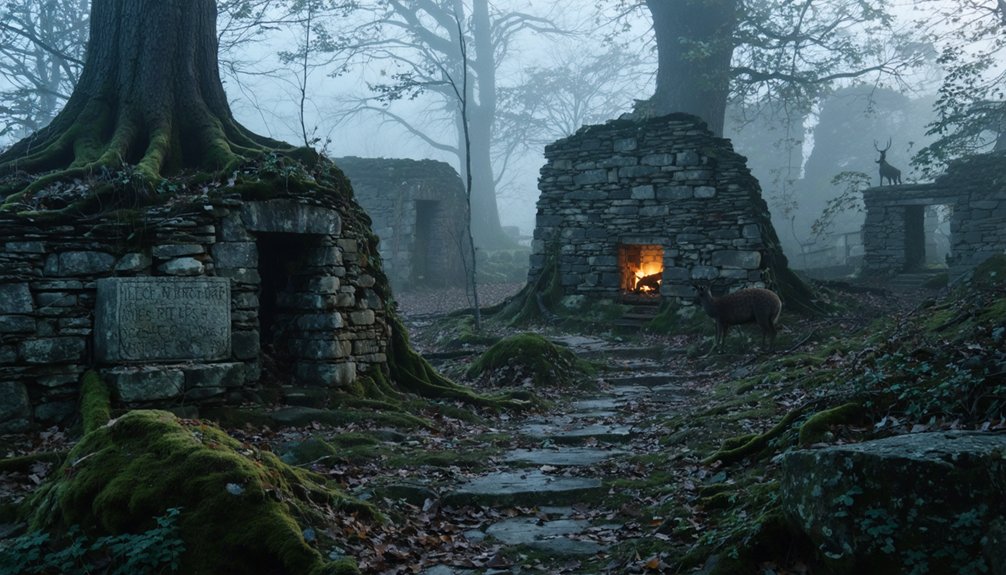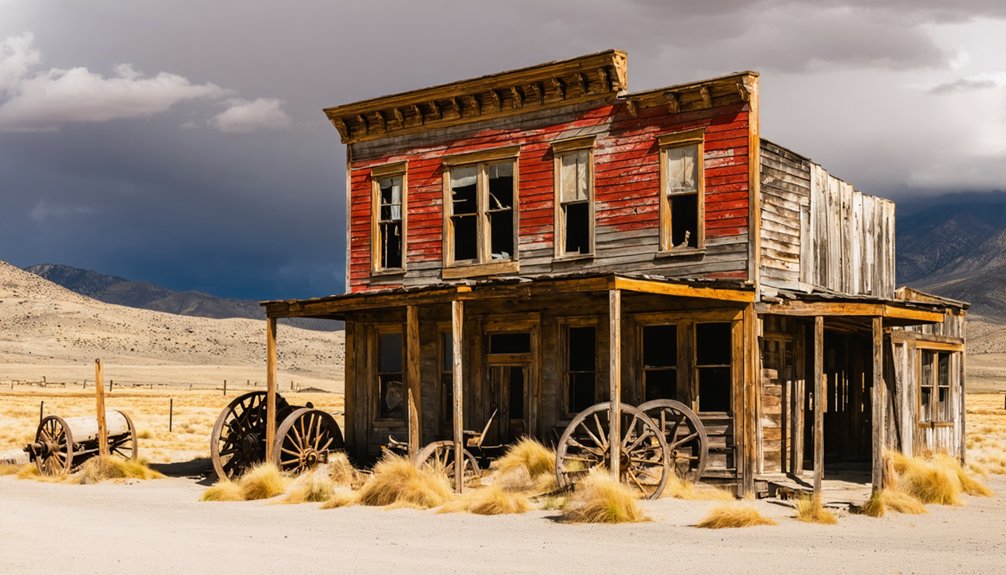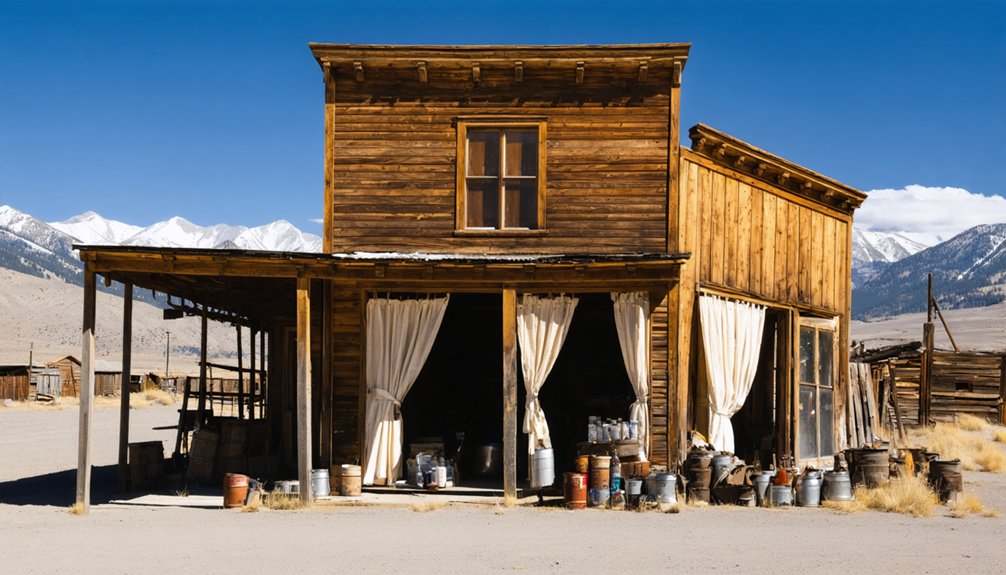America’s spookiest ghost towns offer windows into abandoned dreams and eerie histories. You’ll find gold rush remnants in Bodie with buildings in “arrested decay,” perpetually burning Centralia forcing mass evacuation, and Cahawba with its spectral orbs. Don’t miss Dogtown’s mysterious carved boulders, submerged Flagstaff that emerges during low water, or mercury-contaminated Terlingua. These time capsules of American life stand frozen yet hauntingly preserved, waiting to reveal their spine-tingling stories.
Key Takeaways
- Bodie, California is preserved in “arrested decay” with 110-170 buildings and claims of paranormal activity.
- Centralia, Pennsylvania features an underground coal fire burning since 1962 that inspired the Silent Hill horror franchise.
- Cahawba, Alabama is known for spectral orbs appearing in photographs, especially near Castle Morgan and the African American cemetery.
- Bannack, Montana has over 60 historic structures with reported paranormal activity, including its notoriously haunted Masonic Lodge.
- Dogtown, Massachusetts housed marginalized women and widows who kept dogs for protection, contributing to its haunted reputation.
Bodie, California: The Gold Rush Frozen in Time
Nestled east of the Sierra Nevada Mountains, Bodie stands as a tribute to America’s gold rush era, where prospectors’ dreams were born and shattered in equal measure.
After William Bodey’s 1859 gold discovery, a boomtown erupted, reaching an impressive 10,000 residents by 1880 with 65 saloons and countless businesses.
From humble beginnings to a raucous metropolis, Bodie’s explosive growth epitomized the feverish allure of gold rush prosperity.
You’ll find Bodie history preserved in its purest form—110 to 170 buildings remain in “arrested decay,” with interiors undisturbed since their abandonment.
The ghost town yielded over $70 million in precious metals before rich veins played out and devastating fires accelerated its decline.
Now a National Historic Landmark and California’s official gold rush ghost town, Bodie welcomes 200,000 visitors annually who can witness authentic remnants of America’s ambitious frontier spirit. The town earned a notorious reputation as one of the wildest towns in the West, with its inhabitants often described as Badman from Bodie.
Visitors are warned not to remove any artifacts due to the legendary curse of Bodie, which is said to bring misfortune to anyone who takes items from the town.
Centralia, Pennsylvania: The Town That’s Still on Fire
Located beneath the rugged terrain of eastern Pennsylvania, Centralia presents perhaps America’s most disturbing example of environmental disaster turned ghost town.
The fire origins trace to May 1962, when borough officials ignited trash in a landfill over an abandoned mine entrance without proper clay barriers. Flames penetrated unsealed openings, igniting coal seams below.
For over 60 years, this inferno has burned up to 300 feet deep across 3,700 acres. The underground dangers forced most residents to evacuate by the 1980s—toxic gases vent from the ground, while sinkholes threaten to collapse without warning. Experts estimate the fire could continue burning for at least 250 more years at its current rate.
In 1981, a 12-year-old boy nearly fell into a gas-filled pit. Once home to 1,500 people, this condemned town now stands largely abandoned, yet continues drawing curious visitors despite official warnings. The site has even inspired popular horror media, including the famous Silent Hill movie.
Cahawba, Alabama: From State Capital to Ghostly Ruins
You’ll walk among the forgotten ruins of Cahawba, which evolved from Alabama’s prestigious first state capital in 1820 to a desolate ghost town by the 1870s.
The town’s decline accelerated dramatically after a devastating seven-day flood in 1865 during the Civil War, which caused widespread sickness and prompted residents to abandon their homes. Once a thriving cotton distribution hub, Cahawba lost its economic significance when the Confederate army appropriated the iron rails that connected it to other areas.
Cahawba was historically significant during the Civil War when it housed over 3,000 Union soldiers in the Kahaba Federal Prison, converted from an old cotton warehouse.
Today, visitors report mysterious orbs of light appearing in photographs taken at the Old Cahawba Archaeological Park, particularly near the abandoned cemetery and courthouse where freed slaves once gathered during Reconstruction.
Political Glory, Then Abandoned
Alabama’s grand ambitions materialized in Cahawba, a planned city designated as the state’s first permanent capital on February 13, 1818—remarkably, before construction had even begun.
Governor Bibb envisioned it as a symbol of political aspirations following Creek Nation defeat, building a notable two-story statehouse at Vine and Capitol streets.
After serving as capital until 1826, Cahawba transformed into a thriving cotton distribution center, with Greek Revival mansions reflecting the town’s prosperity.
However, this glory proved temporary. A devastating seven-day flood in 1865, combined with the loss of county seat status to Selma in 1866, accelerated economic decline.
The Civil War’s aftermath briefly saw freedmen occupy abandoned government buildings, but by 1900, nature had reclaimed the site.
You’ll now find only scattered ruins where 3,000 residents once lived. The site’s location at the confluence of rivers made it both strategically valuable for trade and tragically vulnerable to flooding. During the Civil War, the town housed over 3,000 Union prisoners in the notorious Castle Morgan prison camp.
Civil War Flooding Aftermath
While the Civil War raged across the divided nation, Cahawba faced a double catastrophe that would seal its fate as a ghost town.
The Confederate Army’s conversion of a cotton warehouse into Castle Morgan prison brought thousands of Union soldiers to a facility designed for only 500, creating dangerous overcrowding amid rampant disease outbreaks.
In 1865, as the war neared its end, catastrophic flood damage transformed the town into a virtual lake for weeks, destroying homes and infrastructure already weakened by years of conflict.
This environmental disaster, combined with the economic collapse following the loss of slave labor and railway infrastructure, made recovery impossible. Negotiations for prisoner exchanges often took place at the impressive Crocheron Mansion nearby.
The county seat relocated to Selma in 1866, and within a decade, most buildings were dismantled as residents abandoned the once-promising capital that had previously been a major distribution point for cotton with over 3,000 residents.
Spectral Orbs Phenomenon
Amid the crumbling ruins of Cahawba, countless visitors have documented an enigmatic paranormal phenomenon: spectral orbs that appear as luminous, floating spheres in photographs and videos taken at night.
These ghostly legends are particularly prevalent around Castle Morgan’s remains, where hundreds of Union soldiers died in the Confederate prison, and the historic African American cemetery.
You’ll find these spectral sightings most frequently reported near burial grounds and the Perine artesian well, where paranormal investigators attribute them to residual energy from the town’s tragic past.
The orbs seem connected to Cahawba’s layered history—built atop Native American settlements, transformed from state capital to Civil War prison, then abandoned to flooding and disease.
Today, as you explore Alabama’s archaeological park, you’re walking through a location consistently ranked among America’s most haunted places.
Dogtown, Massachusetts: Legends Among the Cellar Holes

Nestled in the wooded terrain of Massachusetts’ Cape Ann peninsula, Dogtown stands as one of America’s most enigmatic ghost towns, where cellar holes and boulder-strewn landscapes tell stories of a community long vanished. Founded in 1693 as a refuge from coastal threats, this settlement once housed nearly 100 families before being abandoned by 1830.
Dogtown folklore centers on its final inhabitants—marginalized women, widows, and freedmen like Thomazine Younger, the “Queen of the Witches,” and Cornelius “Black Neil” Finson. The community’s name derives from dogs kept by widows for protection after the Revolutionary War.
Today, you’ll find Roger Babson’s Depression-era carved boulders among the ruins. The Dogtown haunted reputation persists through stories of witchcraft, eerie sounds, and disoriented hikers—drawing ghost hunters and history enthusiasts to its mysterious trails.
Flagstaff, Maine: The Ghost Town Beneath the Lake
Unlike most abandoned settlements that slowly fade into obscurity, the town of Flagstaff, Maine met a more dramatic end when it was deliberately submerged beneath the waters of what’s now Flagstaff Lake in 1950.
When the Long Falls Dam was constructed on the Dead River for hydroelectric power, entire communities—Flagstaff, Bigelow, and Dead River—were sacrificed through eminent domain.
You can still glimpse this submerged history when water levels drop, revealing foundations and street outlines of communities that once thrived since the 1800s.
Many residents reluctantly relocated, watching as their homes were dismantled or burned before the flooding. The schoolhouse remains as a tangible link to this past, while scuba divers explore the underwater remnants of a community whose final gathering was the poignant Old Home Days celebration in July 1949.
Garnet, Montana: Where Silver Miners Still Roam

High in Montana’s Granite County, the ghost town of Garnet stands as a tribute to America’s turbulent mining history, though its name suggests silver mining rather than its actual gold-based economy. Founded in 1895, Garnet’s mining operations distinguished themselves through hard rock extraction rather than the placer mining common elsewhere.
The town boomed to nearly 1,000 residents by the early 1900s before a devastating 1912 fire, followed by two world wars, gradually emptied its hastily constructed buildings.
Today, under Bureau of Land Management stewardship, Garnet’s well-preserved structures have earned National Register of Historic Places recognition.
You’ll find homes, saloons, and commercial buildings frozen in time—perhaps alongside what some claim are ghostly residents, remnants of the community that once gambled, danced, and carved out existence in this remote mountain setting.
Rhyolite, Nevada: Death Valley’s Decaying Desert Dream
Rising from the Bullfrog Hills of western Nevada in 1904, Rhyolite stands as one of America’s most striking ghost towns, a silent monument to the boom-and-bust cycle of Western mining ventures.
After prospectors Harris and Cross discovered gold, this desert settlement exploded from a tent city to a modern boomtown of 5,000 residents within months.
Rhyolite’s mining legacy quickly materialized in stone buildings, including the iconic Cook Bank Building that remains Nevada’s most photographed ruin.
Bannack, Montana: Wild West Justice and Lingering Spirits

Bannack’s transformation from a bustling gold rush settlement founded by “Pikes Peakers” in 1862 to Montana’s first territorial capital exemplifies the rapid rise and fall typical of frontier boomtowns.
You’ll encounter the dark legacy of vigilante justice in this well-preserved ghost town, where Sheriff Henry Plummer and approximately 20 others were executed at the town gallows, their spirits reportedly still wandering the over 60 historic structures.
The paranormal activity concentrates in several locations, including Hotel Meade and the Masonic Lodge, where visitors report cold spots, moving doors, disembodied voices, and shadowy figures that contribute to Bannack’s reputation as one of America’s most haunted abandoned settlements.
Vigilante Justice Reigns
The committee’s swift justice culminated on January 10, 1864, when they hanged Plummer and his deputies at Bannack’s gallows.
In total, twenty suspected outlaws faced execution, dramatically reducing crime in the region.
Though controversial among residents, these actions established temporary security in the community.
The outlaw legacies persist today through reported hauntings, particularly around the jail and gallows, where visitors claim to encounter Plummer’s restless spirit and hear unexplained phenomena.
Gold Rush Beginnings
When gold was discovered on July 28, 1862, by John White and his “Pikes Peakers” colleagues from Colorado, Bannack’s transformation from desolate creek bed to boomtown began virtually overnight.
By October, over 400 miners had established themselves along what was renamed Grasshopper Creek, creating a vibrant hub of gold rush legends.
The settlement quickly earned the nickname “New Eldorado of the North” due to its exceptionally pure gold content of 99-99.5%.
Mining camp culture flourished as the population exploded to 3,000-5,000 by summer 1863. This influx brought not just miners but an entire economic ecosystem of merchants, gamblers, and various service providers.
While miners established a court system for claim disputes, the town still experienced the lawlessness characteristic of rapid frontier development during this formative period.
Haunted Masonic Lodge
Standing majestically at the heart of what was once Montana’s first territorial capital, the Bannack Masonic Lodge No. 16 represents a fascinating intersection of frontier justice and paranormal lore. Established in 1863 with Nebraska’s authorization, the lodge played an essential role in maintaining order during tumultuous gold rush days.
Many of its members joined the Vigilante Committee that brought notorious sheriff Henry Plummer to justice.
Today, the 1871 two-story structure remains one of the most haunted buildings in Bannack State Park. You’ll discover:
- Unexplained phenomena reported by visitors during tours of the building
- Ghostly encounters that seem to echo the Masonic rituals once performed in its upper chamber
- Paranormal investigators regularly documenting strange occurrences within its walls
The lodge’s preservation offers you a glimpse into frontier life while potentially experiencing lingering spirits from Montana’s Wild West era.
Thurmond, West Virginia: The Railroad Ghost Town
Tucked along the scenic New River in Fayette County, Thurmond, West Virginia represents one of America’s most well-preserved railroad ghost towns. Founded by Confederate Captain William Thurmond in 1873, this once-bustling hub grew from a single house into a thriving commercial center after the Chesapeake & Ohio Railroad established its mainline.
At its peak, Thurmond’s prosperity was staggering—handling more freight than Richmond and Cincinnati combined, with 95,000 annual passengers traversing its depot.
The economic might of this tiny Appalachian town once surpassed major cities through its railroad dominance.
The Thurmond history reflects America’s transportation revolution: as automobiles gained popularity in the 1920s and diesel locomotives reduced coal demand, the town began its decline.
Railroad decline accelerated when local mines closed, and by mid-century, most residents had departed, leaving only five inhabitants today.
Terlingua, Texas: The Mercury Mining Wasteland
While Thurmond’s story revolves around the rise and fall of railroads, the ghost town of Terlingua, Texas tells a different tale of American extraction and abandonment.
Once a thriving mercury mining center with up to 2,000 residents, Terlingua’s ghostly ruins now stand as evidence to America’s industrial past.
When you visit, you’ll find:
- Weathered limestone structures that housed miners who extracted cinnabar ore from 1886 to 1973
- A historic cemetery with graves telling stories of mining accidents, mercury poisoning, and the 1918 influenza epidemic
- Environmental contamination that persists, making Terlingua an ongoing study site for mercury phytoremediation
The abandoned Chisos Mining Company facilities, once America’s largest mercury producer, now welcome adventurers seeking freedom among the haunting remnants of this boom-and-bust cycle.
St. Elmo, Colorado: Abandoned in Haste
When gold and silver deposits were discovered in Colorado’s Chalk Creek Canyon in 1878, the settlement originally known as Forest City rapidly transformed into St. Elmo.
Within years, this mining boomtown flourished with nearly 2,000 residents, complete with essential infrastructure and vibrant social establishments.
St. Elmo’s mining legacy centered around the 150+ patented claims within the district, particularly the Mary Murphy Mine.
The Denver South Park & Pacific Railroad facilitated this economic boom until service ended in 1922, marking the beginning of the town’s decline.
Batsto Village, New Jersey: The Forgotten Iron Town
You’ll find Batsto Village tucked away in New Jersey’s Pine Barrens, an industrial pioneer that once produced critical iron supplies for the Continental Army during the Revolutionary War.
The village’s forty preserved buildings offer a glimpse into 19th-century industrial life, showcasing the Richards family’s 92-year management and later Joseph Wharton’s ownership.
While the last permanent resident departed in 1989, the restored settlement continues to intrigue visitors with its mysterious ambiance and historical significance as a forgotten industrial powerhouse within the notoriously enigmatic Pine Barrens region.
Industrial Revolution Pioneer
Nestled within New Jersey’s Pine Barrens, Batsto Village stands as one of America’s most significant industrial revolution pioneers, established in 1766 by Charles Read as an ironworks that strategically exploited the region’s natural resources.
The site’s industrial legacy flourished during the Revolutionary War when it supplied critical military iron goods to Continental forces.
Under William Richards’ ownership beginning in 1784, Batsto transformed into a self-sustaining industrial community with historical significance that extended beyond ironworking:
- Workers received exemption from military service, underscoring their essential contribution to America’s fight for freedom.
- The village expanded to include glassmaking operations by 1846, diversifying its manufacturing base.
- Despite eventual decline from emerging technologies, over 40 preserved structures remain today.
Restored Historic Buildings
The restoration of Batsto Village stands as a remarkable achievement in historic preservation, transforming what might’ve been lost ruins into one of America’s most extensive industrial heritage sites.
When you visit, you’ll explore over 30 meticulously restored buildings showcasing diverse architectural styles from the 18th and 19th centuries.
The centerpiece Batsto Mansion, once home to the ironmaster, contrasts with the modest workers’ cottages that housed industrial laborers. You’ll witness the restored iron furnace that once powered this thriving community, alongside the gristmill and sawmill that sustained village life.
Restoration efforts employ historically accurate materials and techniques—local timber, mortise-and-tenon joints, and period-appropriate paint colors—ensuring authenticity throughout the complex.
These preserved structures now serve as living classrooms where America’s industrial heritage remains tangible.
Pine Barrens Mystery
Deep within New Jersey’s enigmatic Pine Barrens, Batsto Village emerges as one of America’s most intriguing industrial ghost towns, revealing the complex intersection of natural resources and early American entrepreneurship.
The village’s bog iron legacy began in 1766 when Charles Read established an industrial center that would later supply the Continental Army during the Revolution.
When you explore this preserved Pine Barrens folklore site, you’ll discover:
- A complete company town with 33 structures including workers’ homes, a mansion, and industrial buildings
- The ecological phenomenon of bog iron that fueled its rise before Pennsylvania coal led to its decline
- Joseph Wharton’s failed attempts to revitalize the village through glassmaking and agriculture
Today, you can walk freely among these authentic ruins—tangible reminders of America’s industrial heritage now reclaimed by the wilderness.
Kennecott, Alaska: The Copper Ghost of the North
Hidden among the rugged Alaskan wilderness, Kennecott stands as one of America’s most remarkably preserved mining communities, offering visitors a glimpse into the copper boom that transformed the region in the early 20th century.
Discovered in 1900 by prospectors Warner and “Tarantula” Jack Smith, Kennecott history began with the Bonanza claim—the world’s purest copper deposit. By 1911, the Alaska Syndicate had developed a 14-story mill and 196-mile railway to transport the precious ore.
During its 1911-1938 operation, Kennecott extracted $200 million in copper (worth billions today).
When the mines closed in 1938, residents abandoned the town almost instantly, leaving behind personal belongings.
Now a National Historic Landmark within Wrangell-St. Elias National Park, you’ll find the iconic red mill buildings frozen in time—a haunting representation of America’s copper mining legacy.
Frequently Asked Questions
Are There Any Fully Accessible Ghost Towns for Disabled Visitors?
No ghost towns are fully accessible, though you’ll find adaptive tours at Bodie State Historic Park and partial wheelchair access at Trans-Allegheny Asylum, where accessible experiences accommodate mobility limitations.
How Do Locals Feel About Tourism to These Abandoned Communities?
Every cloud has a silver lining. You’ll find local opinions vary widely—many residents appreciate tourism’s economic impact, while others worry about authenticity loss, overcrowding, and rising costs in their once-quiet communities.
Which Ghost Town Has the Most Documented Paranormal Activity?
Virginia City, Nevada has the most documented paranormal activity, with its haunted history generating numerous spectral sightings at the Washoe Club and throughout this former mining boomtown you’ll want to explore.
Can You Legally Remove Artifacts From Ghost Towns?
No, you can’t legally remove artifacts from ghost towns without permission. They’re protected for their historical significance, and removing them violates artifact preservation laws on both public and private land.
Are There Guided Night Tours Available at These Locations?
Ever wondered what lurks after dark? Yes, you’ll find guided nighttime adventures at many locations, including Vulture City, Bodie, and St. Elmo. These tours offer potential ghostly encounters and require advance booking.
References
- https://www.mentalfloss.com/geography/wanderlust/creepiest-ghost-towns-united-states
- https://www.gothichorrorstories.com/real-ghost-stories/
- https://www.geotab.com/ghost-towns/
- https://www.tastingtable.com/694562/scariest-ghost-towns-country/
- https://whakestudios.com/us-ghost-towns/
- https://www.youtube.com/watch?v=SUsnGxOpcss
- https://en.wikipedia.org/wiki/Lists_of_ghost_towns_in_the_United_States
- https://en.wikipedia.org/wiki/List_of_reportedly_haunted_locations_in_the_United_States
- https://www.atlasobscura.com/lists/united-states-of-abandoned-places
- https://www.youtube.com/watch?v=a7zS5kapSVw



